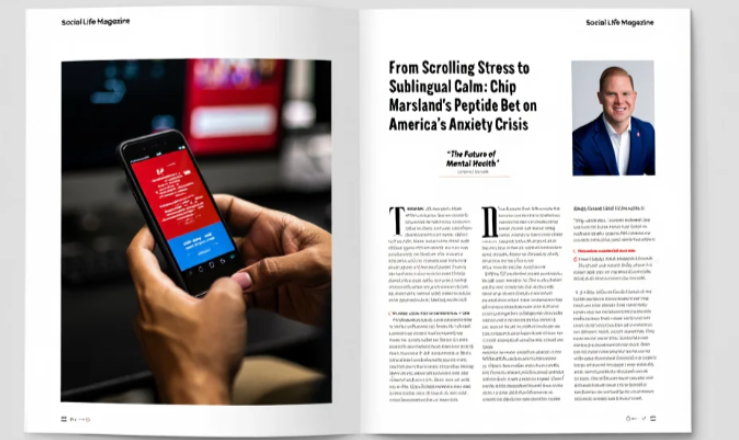yline / July 2025. Last spring a 17-year-old TikTok creator fainted backstage at a Manhattan brand shoot. Her vitals were steady; her social-media feed wasn’t. “I’m on twenty-four-hour call with the algorithm,” she whispered to the EMT. Stories like hers now crowd pediatric clinics, H.R. hotlines, and — increasingly — Washington hearing rooms. The Surgeon General has compared the mental-health fallout of social media to Big Tobacco in the 1990s and urged Congress to slap warning labels on apps that monetize fear loops.
While policymakers debate friction, Chip Marsland is engineering an off-switch.
The Molecule Whisperer
Marsland’s résumé reads like a molecular syllabus: three decades in neuropeptide engineering, 50-plus patents, and a reputation for making biochemistry behave in real-world bodies. Weight-loss headlines made him famous, but insiders have watched his quieter work on neuropeptide Y (NPY) modulators — tiny chains that flood the brain during acute stress to restore calm and blunt cortisol spikes.
Traditional anti-anxiety drugs tune serotonin or GABA. Marsland aims a step upstream, “dimming the entire fight-or-flight console rather than one flickering bulb,” as he puts it. His new wafer, Serenyl™, melts under the tongue in fifteen seconds and promises steadier vitals within fifteen minutes. Early pilot data from a Rochester ER showed a 42 percent drop in self-reported panic intensity before standard Ativan could even be requested.
Why the Timing Hits Home
- Youth mental-health emergency. CDC surveys now show one in four U.S. teens meets criteria for an anxiety disorder; emergency-room visits for teen self-harm have doubled since 2011.
- SSRI fatigue. Prescriptions soar, but efficacy plateaus and discontinuation syndrome scares parents away. Fast-acting, non-sedating options are rare.
- Veteran PTSD backlog. The VA’s 2025 budget earmarks record funds for evidence-based alternatives to benzodiazepines amid rising overdose concerns.
Marsland’s wafer addresses all three chokepoints: it’s non-sedative, quarter-hour fast, and manufactured entirely on U.S. soil — a useful talking point for legislators trying to untangle pharma dependency on overseas peptide suppliers.
The Upstate Stress Lab
Inside a repurposed Kodak plant in Rochester, bioreactors hum like industrial cellos, churning out metric tons of stress-modulating peptides fermented from yeast. Each batch is flash-freeze-dried, milled into pharmaceutical-grade powder, and pressed into mint-size wafers alongside vitamin B-cofactors. Quality-control charts wallpaper the hallways — a quiet flex for a company that hopes to win federal procurement for military flight kits later this year.
Obstacles on the Runway
- Clinical proof. Early numbers impress, but insurers want multi-site, placebo-controlled data before coverage. A 600-patient trial launches in October.
- Regulatory gray zones. Because Serenyl leverages endogenous peptide mimetics rather than controlled substances, the FDA is still drafting an approval pathway. Marsland is lobbying for a “wellness-to-Rx” hybrid similar to medical foods.
- Pricing optics. Marsland vows to undercut branded benzodiazepines, but wafer tech isn’t cheap; sliding-scale programs with state Medicaid systems are in negotiation.
What Happens Next — Key Flashpoints to Watch
- August 12: Surgeon General testifies on proposed social-media warning labels; lawmakers eye solutions that include “physiological buffering” products.
- September 8: VA pilot launches Serenyl across five PTSD clinics; early efficacy data could tilt payer sentiment overnight.
- October 27: Phase 2b multi-site trial enrollment completes, locking a Q1 2026 data readout.
- Year-End: Senate revisits BIOSECURE Act supply-chain credits; domestic peptide plants stand to gain, driving investor buzz around Marsland’s Rochester hub.

